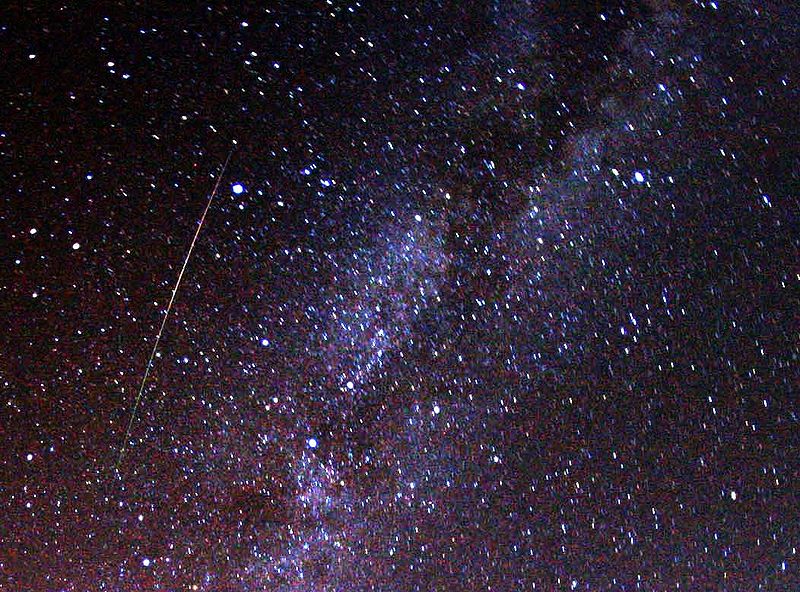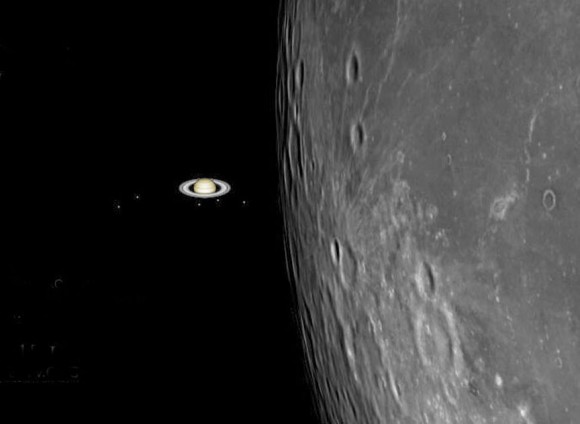
A
new crater appeared sometime between when the MARCI camera aboard
NASA's Mars Reconnaissance Orbiter took these two snapshots. The dark
impact site is about 5 miles (8 km) across.
NASA / JPL / MSSS
- See more at: http://www.skyandtelescope.com/astronomy-news/new-double-martian-crater/#sthash.DXbenlUt.dpufNASA / JPL / MSSS

A
new crater appeared sometime between when the MARCI camera aboard
NASA's Mars Reconnaissance Orbiter took these two snapshots. The dark
impact site is about 5 miles (8 km) across.
NASA / JPL / MSSS
- See more at: http://www.skyandtelescope.com/astronomy-news/new-double-martian-crater/#sthash.DXbenlUt.dpufNASA / JPL / MSSS

A
new crater appeared sometime between when the MARCI camera aboard
NASA's Mars Reconnaissance Orbiter took these two snapshots. The dark
impact site is about 5 miles (8 km) across.
NASA / JPL / MSSS
- See more at: http://www.skyandtelescope.com/astronomy-news/new-double-martian-crater/#sthash.DXbenlUt.dpufNASA / JPL / MSSS

A
new crater appeared sometime between when the MARCI camera aboard
NASA's Mars Reconnaissance Orbiter took these two snapshots. The dark
impact site is about 5 miles (8 km) across.
NASA / JPL / MSSS - See more at: http://www.skyandtelescope.com/astronomy-news/new-double-martian-crater/#sthash.DXbenlUt.dpuf
by Andrea Dunn and Charles W. Lloyd for NASA News
Washington DC (SPX) NASA / JPL / MSSS - See more at: http://www.skyandtelescope.com/astronomy-news/new-double-martian-crater/#sthash.DXbenlUt.dpuf
Maintaining astronaut bone and muscle health in microgravity is an ongoing concern for NASA, and now the agency is "forcing" the issue with a new investigation.
On May 29, 2014, NASA will fly the ForceShoe, designed by XSENS, to the International Space Station (ISS) and, although these shoes don't measure the same force of Star Wars lore, they will help NASA collect data for studying the loads, or force, placed on crew member bodies during exercise on the space station's Advanced Resistive Exercise Device (ARED).
To reduce the loss of bone and skeletal muscle strength experienced by astronauts during long duration spaceflight, NASA developed the ARED. The device provides crew members with the ability to perform weight-bearing exercises in space by supplying resistance through the power of vacuum cylinders.
"ARED is a sophisticated exercise device," said Andrea Hanson, Ph.D. and ISS Exercise Hardware Specialist. "Although it has helped NASA provide better health outcomes for crew members, there is still progress to be made in understanding the effects of exercise on bone and muscle health, and the ForceShoe will help us do that."
A small asteroid slammed into the Martian surface sometime between March 27 and 28, 2012, creating a crater swarm in the ground. The largest pit is 159 feet across.
Mars is turning out to be a useful laboratory for impact specialists. Aside from the occasional meteorite spotted by NASA's rovers, cameras on orbiting spacecraft can readily spot new craters in the Martian surface. Sometimes they're seen as splashes of bright, fresh ice against an otherwise drab landscape, and sometimes they create dramatic ray patterns.

These
aren't the sorts of serendipitous discoveries that result from some
automated image-comparing algorithm. Instead, finding fresh craters
still relies on sets of human eyeballs scanning the wealth of spacecraft
imagery coming back from the Red Planet.
Such was the case with a fresh impact spotted about two months ago. The telltale evidence wasn't found in the super-high-resolution snapshots of the HiRISE camera on NASA's Mars Reconnaissance Orbiter. Instead, it showed up in the daily "global weather" views returned by MRO's wide-angle Mars Color Imager (MARCI).
- See more at: http://www.skyandtelescope.com/astronomy-news/new-double-martian-crater/#sthash.DXbenlUt.dpuf
Mars is turning out to be a useful laboratory for impact specialists. Aside from the occasional meteorite spotted by NASA's rovers, cameras on orbiting spacecraft can readily spot new craters in the Martian surface. Sometimes they're seen as splashes of bright, fresh ice against an otherwise drab landscape, and sometimes they create dramatic ray patterns.

A
new crater appeared sometime between when the MARCI camera aboard
NASA's Mars Reconnaissance Orbiter took these two snapshots. The dark
impact site is about 5 miles (8 km) across.
NASA / JPL / MSSS
NASA / JPL / MSSS
Such was the case with a fresh impact spotted about two months ago. The telltale evidence wasn't found in the super-high-resolution snapshots of the HiRISE camera on NASA's Mars Reconnaissance Orbiter. Instead, it showed up in the daily "global weather" views returned by MRO's wide-angle Mars Color Imager (MARCI).
- See more at: http://www.skyandtelescope.com/astronomy-news/new-double-martian-crater/#sthash.DXbenlUt.dpuf
A small asteroid slammed into the Martian surface sometime between March 27 and 28, 2012, creating a crater swarm in the ground. The largest pit is 159 feet across.
Mars is turning out to be a useful laboratory for impact specialists. Aside from the occasional meteorite spotted by NASA's rovers, cameras on orbiting spacecraft can readily spot new craters in the Martian surface. Sometimes they're seen as splashes of bright, fresh ice against an otherwise drab landscape, and sometimes they create dramatic ray patterns.

These
aren't the sorts of serendipitous discoveries that result from some
automated image-comparing algorithm. Instead, finding fresh craters
still relies on sets of human eyeballs scanning the wealth of spacecraft
imagery coming back from the Red Planet.
Such was the case with a fresh impact spotted about two months ago. The telltale evidence wasn't found in the super-high-resolution snapshots of the HiRISE camera on NASA's Mars Reconnaissance Orbiter. Instead, it showed up in the daily "global weather" views returned by MRO's wide-angle Mars Color Imager (MARCI).
- See more at: http://www.skyandtelescope.com/astronomy-news/new-double-martian-crater/#sthash.DXbenlUt.dpuf
Mars is turning out to be a useful laboratory for impact specialists. Aside from the occasional meteorite spotted by NASA's rovers, cameras on orbiting spacecraft can readily spot new craters in the Martian surface. Sometimes they're seen as splashes of bright, fresh ice against an otherwise drab landscape, and sometimes they create dramatic ray patterns.

A
new crater appeared sometime between when the MARCI camera aboard
NASA's Mars Reconnaissance Orbiter took these two snapshots. The dark
impact site is about 5 miles (8 km) across.
NASA / JPL / MSSS
NASA / JPL / MSSS
Such was the case with a fresh impact spotted about two months ago. The telltale evidence wasn't found in the super-high-resolution snapshots of the HiRISE camera on NASA's Mars Reconnaissance Orbiter. Instead, it showed up in the daily "global weather" views returned by MRO's wide-angle Mars Color Imager (MARCI).
- See more at: http://www.skyandtelescope.com/astronomy-news/new-double-martian-crater/#sthash.DXbenlUt.dpuf
More - Link >>> http://www.spacedaily.com/reports/May_the_Force_Shoes_Be_With_You_999.html
Sources: NASA News, SpaceDaily.com .
2014: 75th Year of Pittsburgh's Buhl Planetarium

Want to receive SpaceWatchtower blog posts in your inbox ?
Send request to < spacewatchtower@planetarium.cc >..
gaw
Glenn A. Walsh, Project Director,
Friends of the Zeiss < http://buhlplanetarium.tripod.com/fotz/ >
Electronic Mail - < gawalsh@planetarium.cc >
About the SpaceWatchtower Editor / Author: < http://buhlplanetarium2.tripod.com/weblog/spacewatchtower/gaw/ >
SpaceWatchtower Blog: < http://spacewatchtower.blogspot.com/ >
Also see: South Hills Backyard Astronomers Blog: < http://shbastronomers.blogspot.com/ >
Barnestormin: Writing, Essays, Pgh. News, & More: < http://www.barnestormin.blogspot.com/ >
SPACE & SCIENCE NEWS, ASTRONOMICAL CALENDAR:
< http://buhlplanetarium.tripod.
Twitter: < https://twitter.com/spacewatchtower >
Facebook: < http://www.facebook.com/pages/
Author of History Web Sites on the Internet --
* Buhl Planetarium, Pittsburgh:
< http://www.planetarium.
* Adler Planetarium, Chicago:
< http://adlerplanetarium.
* Astronomer, Educator, Optician John A. Brashear:
< http://johnbrashear.tripod.com >
* Andrew Carnegie & Carnegie Libraries:
< http://www.andrewcarnegie.
* Civil War Museum of Andrew Carnegie Free Library:
< http://garespypost.tripod.com >
* Duquesne Incline cable-car railway, Pittsburgh:
< http://inclinedplane.tripod.
* Public Transit:
< http://andrewcarnegie2.tripod.









